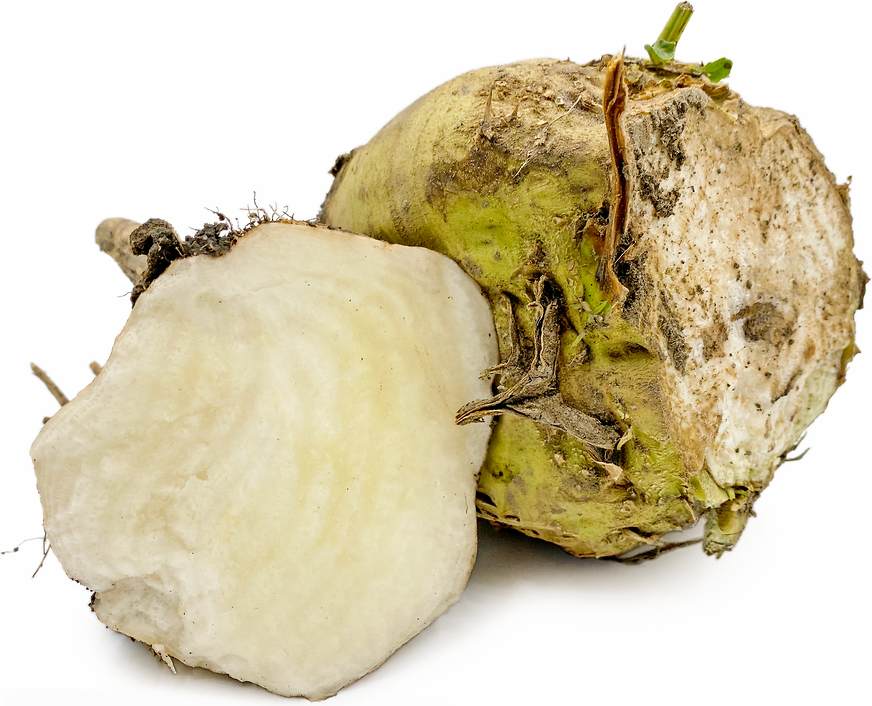


Sugar Beets
Estimated Inventory, lb : 0
Description/Taste
Sugar beets are round, conical, to elongated, tapered roots, averaging 10 to 12 centimeters in diameter, and may have an irregular appearance due to varied soil and growing conditions. The skin is rough, cream-colored, and firm, attached to slender, leathery, and edible green tops that average thirty-five centimeters in length. Underneath the surface of the root, the flesh is crisp, dense, and ivory to white. Sugar beets, when raw, have a semi-bitter flavor and once cooked, the flesh softens and develops a very sweet, bland taste.
Seasons/Availability
Sugar beets are available year-round.
Current Facts
Sugar beets, botanically classified as Beta vulgaris, are a variety of white beet that belongs to the Amaranthaceae family. The cultivar is primarily grown for commercial sugar production and is considered to be a cash crop for many countries around the world. Sugar beets contain one of the highest concentrations of sugar of all the beet varieties, and the sugar is developed from the process of photosynthesis within the leaves. Once the sugar is created in the leaves, it is then transferred and stored into the roots, which can be cooked and squeezed to extract the sweet crystals. It has been reported that approximately twenty percent of the global sugar market stems from Sugar beets, and as cultivation increases, the market share is also expanding. Outside of commercial processing, Sugar beets are not commonly sold in fresh markets and are primarily reserved to home gardens where they are as a specialty variety.
Nutritional Value
Sugar beets are a good source of fiber, which can help regulate the digestive system, and also provide smaller amounts of vitamin C, calcium, and iron.
Applications
Sugar beets are not commonly consumed due to their sweet, bland flavor and are primarily used to produce sugar. Though rarely seen in fresh markets, some home gardeners do cultivate and eat the variety. Sugar beets can be consumed raw when young and are grated and sliced into green salads. The roots can also be used when mature, but the flesh must be cooked to develop a softer texture, primarily utilized in boiled, sautéed, and roasted applications. Sugar beets can be roasted for a sweet, caramelized flavor and are often mixed with other bitter root vegetables to balance out the flavor. They can also be cooked and tossed into green salads, substituted for white potatoes in latke recipes, or roasted as a side dish. In Germany, Sugar beets are frequently processed into a syrup known as Zuckerruben-Sirup. This thick liquid is created from boiled and pressed beet pulp, and the dark-hued syrup is a favorite natural sweetener, baking ingredient, sauce, and spread for toast. Sugar beet pulp has also been recently processed into a fiber additive that is being incorporated into cereals. Beyond the roots, Sugar beet greens can be sautéed and used as a side dish or mixed into stir-fries as a spinach substitute. Sugar beets pair well with parsnips, radishes, potatoes, cardamom, ginger, walnuts, winter greens, and sour cream. The roots will keep 1-2 weeks when stored whole and unwashed in the crisper drawer of the refrigerator.
Ethnic/Cultural Info
Sugar beets are known around the world as a cash crop for sugar production, but the pale roots also produce other by-products that are used in commercial goods. In Europe, especially in the Czech Republic, sugar extracted from the beet pulp is incorporated with rum into tuzemak, which is a liqueur that was invented in the 19th century. The drink is commonly consumed in mixed drinks, but it is also used in baking as a flavoring for cookies and cakes. Sugar beets also produce molasses, which can be used in culinary applications around the world, or in Canada, molasses can be combined with non-edible liquids to create strong and stable, de-icing products for major roadways.
Geography/History
Sugar beets are a white beet variety that was originally cultivated in Europe during the 18th century. Andreas Marggraf, a German scientist, discovered that the sugar found in beets was the same as the sugar in sugarcane, and his student Karl Achard eventually extracted the sugar from the roots to create an entirely new market for commercial production. With the new discovery, Sugar beets became a widely cultivated variety around the world, with many countries creating their own sugar factories to compete in the lucrative market. In the modern-day, the United States, Russia, France, the Netherlands, the United Kingdom, Czech Republic, and Germany are some of the top producing countries of sugar from Sugar beets, and the roots are also widely used in making other commercial products, sweeteners, and animal feed. In fresh form, Sugar beets are difficult to find and are primarily sold through local farmer’s markets in Europe, South America, Africa, and North America. The variety is also featured through online seed catalogs for home garden use.
Recipe Ideas
Recipes that include Sugar Beets. One
| Sorted Food |
|
SUGAR BEET LATKES |




